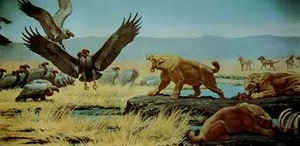
Texas Symbols
Texas State Dinosaur (Old Designation)
Sauropod Dinosaur

(Pleurocoelus)
Adopted on June 3, 1997.
The Sauropod Dinosaur, (Brachiosaur sauropod, Pleurocoelus,) was adopted on June 3, 1997 as Texas's state dinosaur. The Pleurocoelus was a 50-foot-long, plant-eating, lizard-hipped dinosaur. Its tracks can be viewed at Dinosaur Valley State Park near Glen Rose in North Central Texas. Complete skeletons of this dinosaur are unknown, and most material is fragmentary.
Redesignated
The quadrupedal sauropod(Paluxysaurus jonesi) replaced the Pleurocoelus as the official lone star state dinosaur when Governor Rick Perry signed House Concurrent Resolution No. 16 on June 19, 2009.
Texas State Fossil:
Sauropod Dinosaur (Old Designation)

Pleurocoelus was a four-legged browser with front limbs longer than its hind limbs. One of the most abundant dinosaurs of the Early Cretaceous, it had a small, narrow skull and teeth that were similar to Camarasaurus but thinner. Its limbs also resembled Camarasaurus, but Pleurocoelus's toes were more slender than other sauropods. Pleurocoelus tracks have been identified at the Glen Rose, Texas trackway, as have those of Acrocanthosaurus.
Characteristics of the Sauropod Dinosaur
(Old Designation)

Pleurocoelus (PLEW-roh-SEEL-us) means "hollow side" because of the way its vertebrae are scooped out along the sides. This dinosaur left its fossilized footprints in many parts of central and noth-central Texas. The hind feet left huge saucer like depressions with three claw marks up front. The front-foot tracks are smaller and resemble horseshoes. Scientists think that Pleurocoelus must have walked on the tips of its front toes which were enclosed in a kind of padded sheath.
- Description: Herbivore, Quadrupedal
- Order: Saurischia
- Suborder: Sauropodomorpha
- Infraorder: Sauropoda
- Family: Brachiosauridae
- Length: 45 feet
- Weight: 10 tons
- Time: 110-105 million years ago
- Where found: Texas, Maryland, England
- Classification: A sauropod or giant four-legged plant-eating lizard-hip.
- Defense: Plateosaurus had short claws on its front and rear limbs, and weak, leaf-shaped teeth. These paltry defenses were probably not very effective against large predators, which had bigger claws, sharper teeth, and were stronger overall. Its best defense was to run away.
- Notes: Traveled in groups with the young on the inside, so they could be protected by the larger adults.
In 1997 the Brachiosaur Sauropod, (Pleurocoelus,) became the official Lone Star State Dinosaur when Governor George W. Bush signed Senate Councurrent Resolution No. 57 on June 3, 1997.
Texas Senate Concurrent Resolution 57
SENATE CONCURRENT RESOLUTION 57
By: Moncrief
S.C.R. No. 57 97S0912/1
WHEREAS, Texas has become world famous for its many dinosaur discoveries and for many of its unique dinosaur specimens such as the Pleurocoelus; and
WHEREAS, When the sea submerged the Antlers and the Paluxy formations, it put an end to dinosaurs in this region of the earth known as Texas for nearly
five million years, approximately 105 to 100 million years ago; and
WHEREAS, There was an interruption in North America's geographic history caused by the expansion of the sea 100 million years ago, creating the Western
Interior Sea Way which joined the Gulf of Mexico with the Arctic Ocean, thereby essentially splitting North America into two halves and remaining that
way until very near the end of the Age of Dinosaurs, about 66 million years ago; and
WHEREAS, Several formations were laid down in Central Texas during that interval of marine time, fossilizing the remains of the 65 to 70 foot creature
known as Pleurocoelus; and
WHEREAS, Today the footprints of Pleurocoelus created so long ago are visible once more, as featured in the Fort Worth Museum of Science and History's
exhibition, Lone Star Dinosaurs; and
WHEREAS, Sauropods, specifically the species Pleurocoelus, inhabited the earth approximately 200 to 65 million years ago, then died out, leaving the
footprints and bones in rock as young as 105 million years old, preserving this creature's prevalence in and across the State of Texas, causing the
trackway left in Glen Rose, and making this site world famous; and
WHEREAS, All Pleurocoelus disappeared from North America for 35 to 40 million years, then reappeared, returning to what is referred to as the second
dinosaur world in the heart of Texas; and
WHEREAS, Brachiosaur tracks are clearly the footprints of the species Pleurocoelus; they are responsible for not only the tracks in the Glen Rose region
but those scattered across Texas; and
WHEREAS, Because the Pleurocoelus tracks and bone are found mainly in Texas and a small portion of Southeastern New Mexico, this species and its remains
are the last major grouping of the Pleurocoelus, are indigenous to Texas, and are world famous; and
WHEREAS, The important locality referred to as the Jones site excavation of the Pleurocoelus is the biggest dinosaur project undertaken in the State
of Texas led by the Fort Worth Museum of Science and History; and
WHEREAS, These discoveries combined with the leadership of the Fort Worth Museum of Science and History in the field of dinosaur research make the
Pleurocoelus an ideal candidate to be the Lone Star State Dinosaur; now, therefore, be it
RESOLVED, That the 75th Legislature of the State of Texas hereby name the Brachiosaur Sauropod, Pleurocoelus, the official Lone Star State Dinosaur.
Senate Concurrent Resolution No. 57, 75th Legislature, Regular Session (1997)
Taxonomic Hierarchy: Sauropod Dinosaur
Kingdom: Animalia
Phylum: Chordata
Clade: Dinosauria
Suborder: †Sauropodomorpha
Clade: †Titanosauriformes
Family: Pleurocoelidae Marsh, 1888
Genus: Astrodon Johnston, 1859
Species: †A. johnstoni
Synonyms
Pleurocoelus nanus? Marsh, 1888
Pleurocoelus altus? Marsh, 1888

Some states that lack a "state fossil" have nevertheless singled out a fossil for formal designation such as a state dinosaur, rock, gem or stone.






